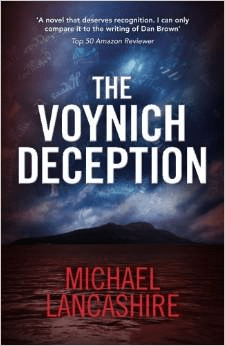I’ve read a lot – and I really do mean a lot – of Voynich Manuscript-themed (and other genuine-historical-cipher-themed) novels over the years, and I have to say that the whole experience rarely gets any better than just-about-OK-if-there’s-nothing-much-on-TV. Yes, even with TV in the nadir-like pit it has winched itself down into these days.
Sad as it is, such novelists’ including-an-ancient-unbroken-cipher writing mechanism comes across to reflective readers as rather, I don’t know, desperate-and-wanting-to-be-loved (and doubtless someone will tell me an obscure German or Icelandic adjective to describe this more precisely). More precisely, it shouts out “please God, let importing some genuine real-world mystery be enough to distract attention from the countless plot flaws, the unconvincing characters, and the piss-poor writing“. And that’s before you’ve even got to page one.
At the same time, none of the above ever hurt Dan Brown, so why not press that button and see where it leads, eh?
Indeed, Michael Lancashire pressed that very button: and to his credit, his novel “The Voynich Deception” comes out of it basically an OK read. As the backdrop to his story, he has an unfeasibly clever guy (‘The Architect’) devising unfeasibly-clever-yet-still-oddly-micromanaged evil plans for ambitious crims to buy to execute. The rest of the plot involves a group of brutal, greedy and unlovable – though utterly uninvolving – Albanian gangsters following a blood-soaked trail of Voynich-linked cookie crumbs ever onwards towards a long-concealed treasure trove, where… well, that last bit would be telling, so my lips are sealed.
But at the same time, what I can say is that the structural weakness of “The Voynich Deception” is that while Lancashire’s ‘Architect’ is just an anti-Sherlock Holmesian conceit, the entire story pivots entirely on a single (admittedly fairly large) twist, one which the author flags very early on. As such, it’s more like a long short story than a novel: and for all the (occasional spatter of) blood ‘n’ gore, it does end up feeling a bit… thin.
Still, Lancashire is respectful towards the Voynich Manuscript (which is good), and he tells his story at a fair old pace, something far too many cipher novelists struggle with (hint: a fight they usually lose ignominiously).
The Kindle ebook version is only £1.99, so it’s not a huge investment or risk. And if you like The Voynich Deception, Lancashire has since written an Architect prequel novella (“Kernel Panic”) for you to move onto. All in all: not my tasse de thé, sure, but a perfectly OK read.

Nick, I’m counting on you to write a coherent and interesting story about the creator of the “Voynich” manuscript — and how his finished product (the “Florentine Manuscript”) ended up in a European museum.
The “Voynich” part of the manuscript is a diary of his reverse “Pilgrimage” from Sahagun and
Leon, Spain to “New Spain”
If you can find any discussion, at all, in the “Voynich” about travelling the pilgrims’ trail to Compostela and boarding a ship for the New World, the discussion which accompanies the ‘Magic” circles will be comprehensible.
Also, look for the appearance and discussion of a scallop shell (St. James the Martyr).
When it comes to feathers and or quills: The feather plumes were still being worn for special celebrations and feast days of the Holy Roman Catholic Church in New Spain. Fray Sahagun even had Psalm books made for the indigenous worshipers/converts.
Still blathering on — bdid1dr
😉
Magic words for Magic Circles: Catalonia – Cresques Abraham, Balearic Islands (Majorca)……Portolan chart dated 1339: Angelino Dulcert (BNF, Res Ge B 696 ).
Most of these charts would have been available for Fray Sahagun’s perusal.
And BNF, Esp. 30
Another Q ‘right off the wall’ : How did all those pilgrims who walked hundreds of miles to Compostela de Santiago, Galicia (from all over Spain, Portugal, and France) get back home? Maybe Sir Hubert or Diane O’Donovan may have an idea?
I only mention this because Bernardino de Sahagun mentions his education at the University Santiago de Compostela. The town of Sahagun was/is not terribly far from Compostela.